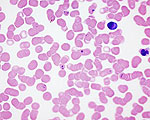Detecting Malaria with Magnets
 Sep-01-14
A new test for malaria that uses magnetic fields to detect the parasite's waste in infected blood cells could provide an earlier—and reliable—diagnosis of the disease.
Sep-01-14
A new test for malaria that uses magnetic fields to detect the parasite's waste in infected blood cells could provide an earlier—and reliable—diagnosis of the disease.Developed by the Singapore-MIT Alliance for Research (SMART), the technique uses magnetic resonance relaxometry (MRR), to detect hemozoin in the blood cells. When the parasite eats the host's hemoglobin, the hemoglobin breaks down—releasing iron. The parasite then converts the iron to hemozoin, which has a magnetic field that will interfere with the spins of hydrogen atoms.
When the hydrogen atoms are exposed to a powerful magnetic field, they will adjust their spins accordingly. Applying a second, smaller field should cause the atoms to change their spins all at the same time, but the presence of hemozion will interfere with that synchronicity. By measuring how quickly that synchrony is disrupted, researchers can determine the severity of the infection.
More Info about this Invention:
[GIZMODO.COM][NEWSOFFICE.MIT.EDU]

Add Your Comment